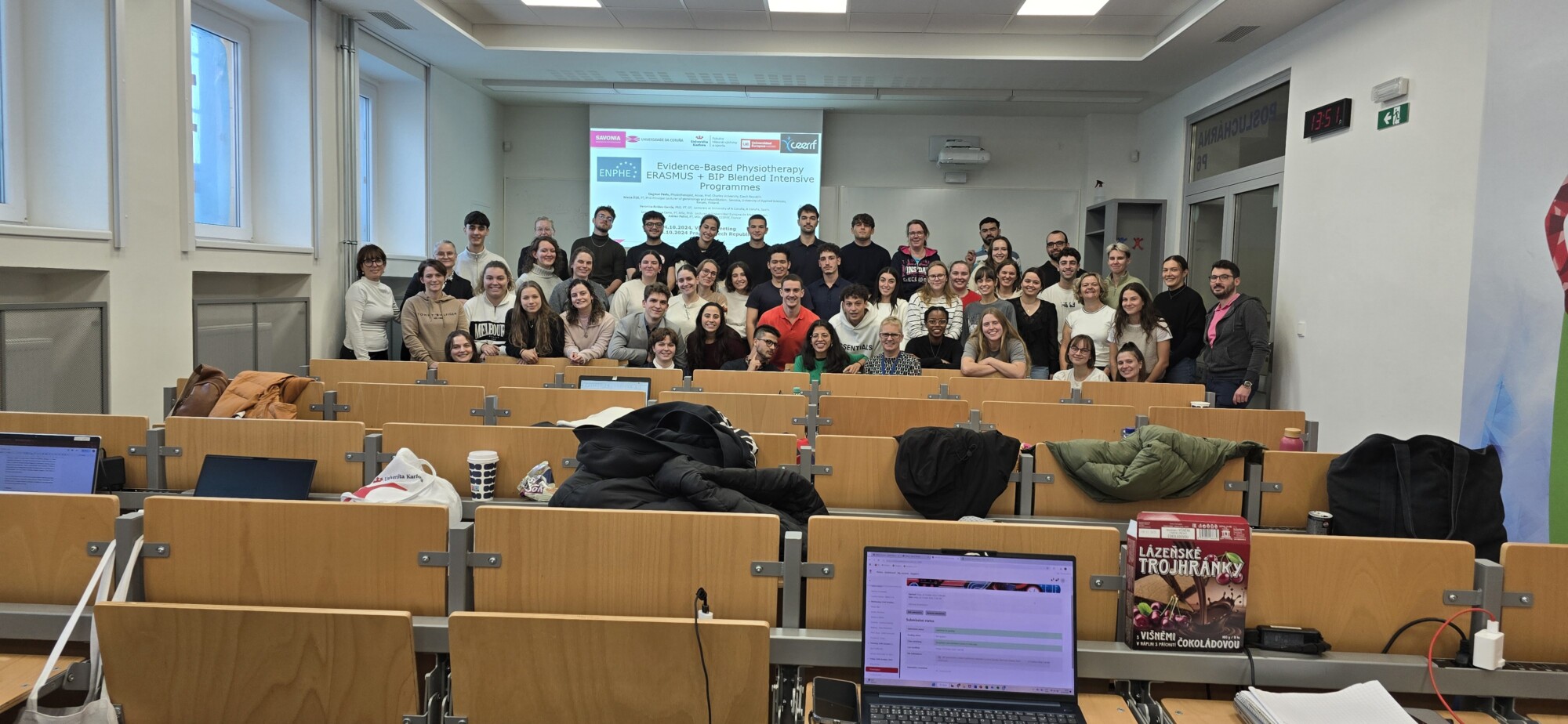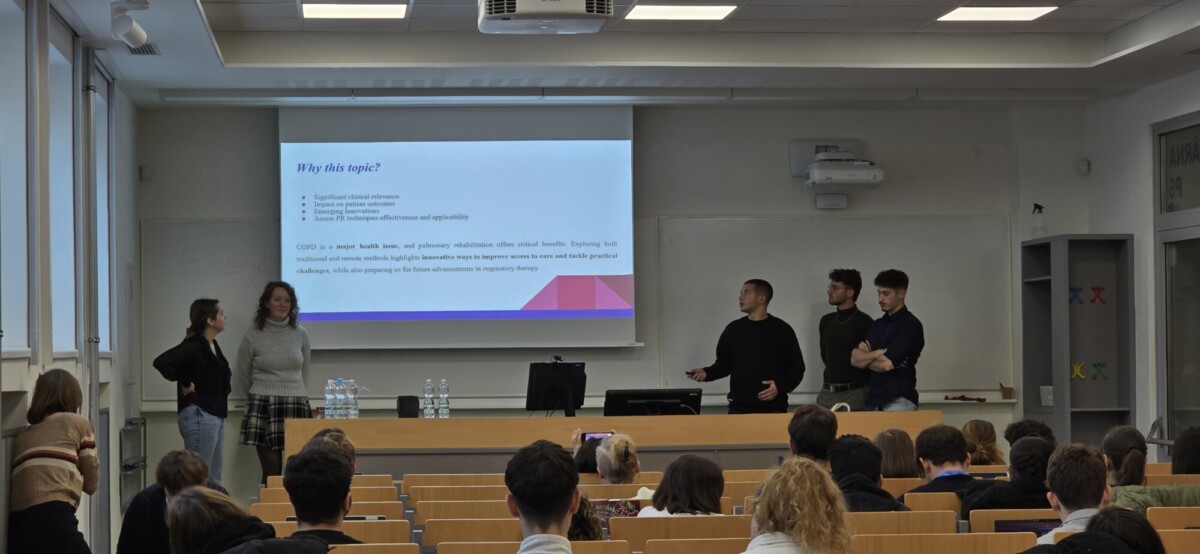
Savonia Article Pro: Telerehabilitation VS Face-to-face treatment in COPD
Savonia Article Pro is a collection of multidisciplinary Savonia expertise on various topics.
This work is licensed under CC BY-SA 4.0
Introduction
Evidence-Based Physical Therapy (EBP) uses the best research evidence with clinical expertise and user’s preferences to produce the most appropriate and effective care. At week 43 in 2024, we had Blended Intensive program (BIP) in Czech Republic, Charles University about EBP. This BIP program opened with welcome words of the president of The European Network of Physiotherapy in Higher Education (ENPHE) and followed with the basis of EBP and teachers who highlighted the main challenges at different Physical Therapy fields.
More than 43 physiotherapy students and 8 teachers from five universities (Savonia University of Applied Sciences, Finland, Universidade da Coruña, Spain, Charles University Prague, Universidad Europea de Madrid, Spain and CEERRF, France), actively participated this week and shared experiential group dynamics and social activities (Picture 1). Students worked together and wrote articles devoted to the following themes: Evidence Based in sport, prevention, injuries, neurological diseases, respiratory diseases, cardiovascular diseases, children and older adults. In this learning task, students practiced conducting a mini review and using PEDro scale to assess the quality of a studies. In the following you can consult the work presented by the students on Chronic obstructive pulmonary disease topic.

Background
We chose to focus on pulmonary rehabilitation (PR) for chronic obstructive pulmonary disease (COPD) due to its significant clinical relevance and impact on patient outcomes. COPD is a leading cause of mortality worldwide, affecting millions of people, and respiratory physiotherapy is a critical component of its management. Pulmonary rehabilitation offers proven benefits, including improved exercise tolerance, reduced breathlessness, and enhanced quality of life.
Moreover, the evolving field of tele-rehabilitation adds an innovative dimension to respiratory care, allowing us to explore cutting-edge solutions to real-world challenges, such as access to care in remote or underserved populations. By examining both traditional and alternative rehabilitation methods, such as home-based or online PR, we aim to assess their effectiveness and applicability, which directly contributes to the growing demand for accessible, patient-centered healthcare; furthermore, this topic is not only scientifically rich but also highly relevant to the future of physiotherapy practice (Picture 2).

Aim
The aim of our blog article was to analyze the role of pulmonary rehabilitation, particularly in the management of COPD, and explore how innovations like tele-rehabilitation are transforming access to respiratory care. We examined both the physiological benefits of rehabilitation and the practical challenges of delivering these interventions, particularly in diverse healthcare settings. Additionally, we aim to assess the comparative effectiveness of traditional face-to-face programs versus remote options, providing insights into how respiratory physiotherapy can evolve to meet patient needs more efficiently in the future.
Methods
Eligibility criteria:
In this mini review we considered only randomized control trials (RCTs). To be included, the trials had to have researched an influence of either standard pulmonary rehabilitation or telerehabilitation or compare those two approaches in patients with COPD. Recent studies were preferred and only those in English, Czech, Spanish and French. We were interested in studies that used 6 minutes walking test as their indicator. Improvement in that measurement was our primary outcome, while an improvement of the quality of life was considered a secondary outcome.
Study selection:
Studies were searched using MeSH terms from 2 databases (PubMed and ScienceDirect). From the initial more than 600 000 studies (on PubMed) and over 1 million (on ScienceDirect) we excluded those that did not satisfy our criteria and finally we ended up with 23 studies. After reading titles and abstract we excluded 18 more and we were left with 5, which were then reviewed by 5 reviewers (1-5) (one for each).
Results
We worked with RCT’s dated from 2014 to 2022 which had sample sizes varied between 84-134 patients with COPD. All the RCT’s worked with similarly old patients in average between 60-70. Two studies were done only on one site and the remaining happened in three or more sites. All inclusion criteria included some sort of assessment of dyspnea or FEV. Intervention programs consisted of at least two sessions per week in the telerehabilitation programs. The two shortest programs took 6 weeks whereas the longest program took 4 months. In all cases the outcomes were measured with help of the 6-minute walk test distance, three RCT’s also included the COPD Assessment Test. Results of all interventions showed improvement in the 6-minute walk test distance, in the RCT’s that compare telerehabitation with face-to-face rehabilitation there was no significant difference between the groups.
Conclusion
Pulmonary telerehabilitation (TR) has proven to be an effective and safe alternative to conventional pulmonary rehabilitation (PR) in patients with COPD, with the potential to reduce hospitalizations and emergency visits, as well as improve long-term health status. TR programs allow patients to perform unsupervised exercises from home, achieving significant improvements in exercise capacity and quality of life, which is especially beneficial for those in remote areas or without access to rehabilitation centers.
Studies also suggest that TR is not inferior to traditional PR in terms of improving functional capacity, as measured by the six-minute walk distance test (6MWT), although adherence to the program appears to be higher in TR. This model has the potential to improve access to PR and meet the growing demand for interventions in COPD patients, especially those with complex conditions like congestive heart failure (CHF). Additionally, TR offers a way to expand PR services, complementing in-person programs and enabling a broader reach to socially and geographically isolated groups. This could reduce costs, increase care capacity, and improve the management of chronic patients through a personalized, home-based approach, highlighting the need for further studies to assess the economic and clinical benefits of large-scale implementation.
Authors:
Daniel Romasanta, physiotherapy student, University of A Coruña, Spain
Léna Rosset, physiotherapy student, CEERRF, France
Michael Drechsler, physiotherapy student, Charles University, Czech Republic
Zuzana Eremiášová, physiotherapy student, Charles University, Czech Republic
Pablo Ibáñez, physiotherapy student, Universidad Europea de Madrid, Spain
Dagmar Pavlu, Physiotherapist, Assoc. Prof. Charles University, Czech Republic
Marja Äijö, PT, PhD Principal Lecturer of gerontology and rehabilitation. Savonia, University of Applied Sciences, Finland
Veronica Robles García, PhD. PT. OT. Lecturers at University of A Coruña, A Coruña, Spain
Lorena Canosa Carro, PT, MSc, PhD. Lecturer at Universidad Europea de Madrid, Spain
Ivana Vláčilová, Physiotherapist, PhD. Charles University, Czech Republic
Beatriz Martínez Toledo, PT. Lecturer at University of A Coruña, A Coruña, Spain.
Montserrat Fernández Pereira, PT, Lecturer at University of A Coruña, A Coruña, A Coruña, Spain.
Adrien Pallot, PT, MSc, Lecturer at CEERRF, France
REFERENCES:
[1] Zanaboni P, Dinesen B, Hoaas H, Wootton R, Burge AT, Philp R, et al. Long-term Telerehabilitation or Unsupervised Training at Home for Patients with Chronic Obstructive Pulmonary Disease: A Randomized Controlled Trial. Am J Respir Crit Care Med 2023;207:865–75.
[2] Hansen H, Bieler T, Beyer N, Kallemose T, Wilcke JT, Østergaard LM, et al. Supervised pulmonary tele-rehabilitation versus pulmonary rehabilitation in severe COPD: a randomised multicentre trial. Thorax 2020;75:413–21.
[3] Bernocchi P, Vitacca M, La Rovere MT, Volterrani M, Galli T, Baratti D, et al. Home-based telerehabilitation in older patients with chronic obstructive pulmonary disease and heart failure: a randomised controlled trial. Age and Ageing 2018;47:82–8.
[4] Bourne S, DeVos R, North M, Chauhan A, Green B, Brown T, et al. Online versus face-to-face pulmonary rehabilitation for patients with chronic obstructive pulmonary disease: randomised controlled trial. BMJ Open 2017;7:e014580.
[5] Cameron-Tucker H, Wood-Baker R, Owen C, Joseph L, Walters E. Chronic disease self-management and exercise in COPD as pulmonary rehabilitation: a randomized controlled trial. COPD 2014:513.